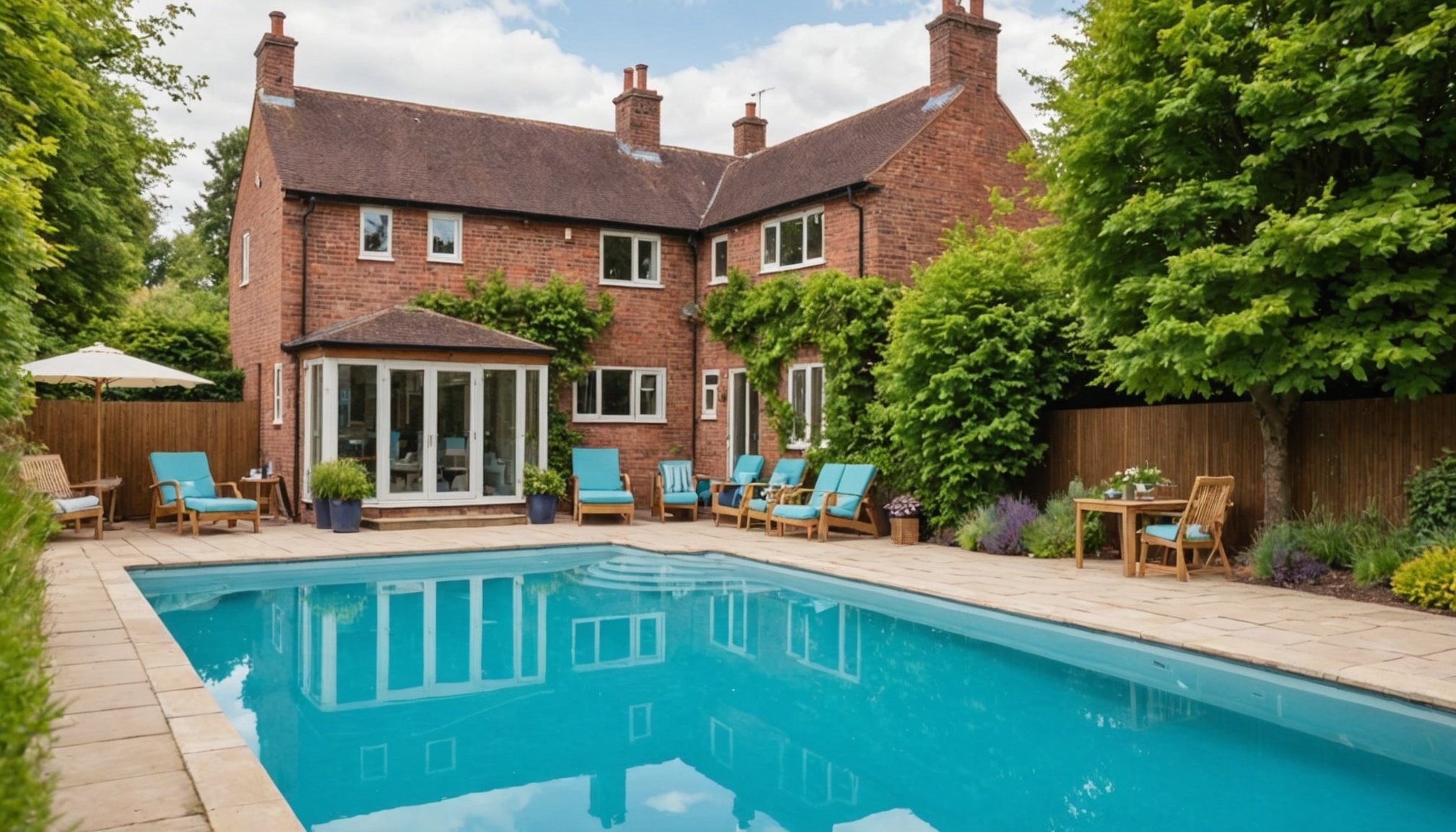Introduction to Safe and Fun Pool Areas for Kids
Creating an enchanting pool area that is both safe and entertaining for children requires careful attention to pool safety and child-friendly designs. In the UK, specific regulations ensure that every splash of fun remains free of hazards. These standards not only protect young swimmers but also give parents peace of mind.
Children’s lively nature makes safety paramount. A pool’s design should prevent accidents with features like barriers, alarms, and slip-resistant surfaces. Potential dangers include drowning risks, slips, and falls. Thus, incorporating preventative measures is essential.
Also to discover : Transform Your UK Garden: Creative Ideas for Designing a Stunning Pool with a Waterfall Feature
UK regulations establish clear guidelines. For instance, proper fencing is crucial, standing at least 1.2 metres high with self-closing gates. Additionally, pools must be equipped with safety equipment like life rings and visible signage. These requirements aim to minimise accidents and ensure swift responses when necessary. Parents should remain vigilant, complementing the physical safety features with their supervision.
By integrating UK regulations with thoughtful design, your pool can be both a playground and a sanctuary for children. Through strategic planning, it is possible to create an environment where families can enjoy magical moments together while keeping safety first.
Have you seen this : Transform Your UK Home: Creative Tips for Designing a Stunning and Functional Pool Area
Key Safety Features for a Child-Friendly Pool
Ensuring a child-friendly pool environment requires integrating essential safety features. A primary concern is effective pool fencing, which acts as an important barrier to prevent unsupervised access. Fencing options should be sturdy, at least 1.2 metres high, with self-closing and self-latching gates—a critical line of defence.
Pool covers are another crucial element in enhancing pool safety. They deter accidental falls and protect against debris. Options include hard-shell covers, which are robust and secure, and mesh covers, which are beneficial for both safety and filtration.
Incorporating child supervision technology, such as alarms and safety sensors, provides an extra layer of protection. Pool alarms can alert guardians when the water is disturbed unexpectedly, while door and gate alarms ensure real-time updates on potential access points. Meanwhile, safety sensors can be placed around the pool area to monitor movements and trigger alerts if necessary.
Combining these safety measures with vigilant supervision creates a secure swimming environment. Safety technology, like alarms and sensors, complements the physical barriers such as fences and covers, offering peace of mind for parents and allowing children to enjoy pool areas with reduced risk.
Designing a Fun and Interactive Pool Area
Creating a pool area that captures the imagination of children involves more than just meeting safety regulations. The key lies in infusing pool design with creative and interactive features that promise enjoyment. An effective approach to children’s excitement is through colorful themes and decorations. Bright colours and playful designs can transform a pool space into a magical realm of adventure. Pools with unique shapes and varying depths are not only visually exciting but also cater to children of all ages, offering different swimming experiences.
Creative Design Ideas
Incorporating elements like slides and fountains can significantly enhance the pool’s interactive appeal. Children delight in slides that twist and turn, adding an aspect of thrill. Fountains, on the other hand, provide an interesting visual and tactile experience, encouraging imaginative play.
Landscaping Around the Pool
Safety doesn’t take a backseat in this creative endeavour. It’s vital to include safe non-slip surfaces and materials that ensure children can play without the risk of slipping. Designing shaded areas is equally important, offering protection against sun exposure—ideal for prolonged playtime.
Landscaping with greenery that complements the pool’s aesthetic can also create a serene environment, making it more inviting for families.
Recommended Materials and Construction Features
Choosing the right pool materials and construction features is vital for creating a vibrant and safe aquatic environment for children. Opting for soft edges can prevent injuries during play, while using tiles that are slip-resistant ensures safety even when surfaces are wet. These selections not only protect young swimmers but also enhance the overall pool experience.
When it comes to durability, surfaces that are both robust and easy to clean are indispensable. Specifically, materials like fibreglass or certain types of concrete boast longevity and require less maintenance. This choice saves time and efforts on upkeep, allowing families more fun time in the pool and less hassle with maintenance.
To enhance the experience, consider water features like sprays or gentle waterfalls that provide interactive play without compromising safety. Families in cooler regions can also consider efficient heating systems. These systems maintain comfortable temperatures, extending the usability of the pool through various seasons.
By prioritising durable solutions, pool owners can ensure a safe and enjoyable space for children. Practical considerations about materials and features allow for exciting pool designs that endure, accommodating all sorts of water adventures year-round.
Maintenance Tips for Family Pool Safety
Pool maintenance is crucial for ensuring family-friendly environments adhere to high standards of cleanliness and safety. A proactive approach begins with regular pool cleaning and maintaining proper water balance. Consistent hygiene ensures water stays pristine and inviting, reducing the risk of infections or irritations.
Scheduling routine inspections of equipment and surfaces plays a vital role in detecting potential issues early. Regular checks prevent equipment failures and confirm the continued effectiveness of safety features such as fences and alarms. Prioritising safety in maintenance entails verifying filter efficiency and ensuring sanitisation systems function optimally, safeguarding both children and adults.
Guidelines also suggest incorporating child safety precautions during maintenance processes. For instance, securely storing chemicals away from children’s reach can prevent accidents. Emphasising the importance of supervision when conducting maintenance tasks adds another layer of protection.
Beyond routine pool maintenance, consider professional assessments to verify compliance with safety regulations. These experts can ensure all protective measures align with legal requirements, providing peace of mind. Adhering to these practices guarantees a safe aquatic space, allowing families to relish leisure time with fewer worries.
Understanding UK Regulations and Guidelines
Creating a safe pool environment for children involves adhering to precise UK pool regulations. These rules are integral in maintaining high safety standards and ensuring compliance with legal requirements. At the heart of these guidelines is the mandate for effective fencing and signage. Fences should be at least 1.2 metres tall with self-closing gates. Clear, visible signage enhances safety by alerting users to potential hazards and guidelines.
The UK also requires pools to have essential safety equipment such as life rings and pool alarms. These tools are critical for ensuring immediate response during emergencies, thereby providing an extra layer of protection. Compliance extends to documenting safety checks and maintaining records, showcasing adherence to regulations.
Regular reporting and documentation of safety practices help pool owners remain aligned with legal obligations. Keeping organised records offers both reassurance and proof during inspections. In addition, reflecting on these documents strengthens safety practices, cementing a pool area’s status as an enjoyable yet secure environment for children. Adhering to these comprehensive standards not only upholds legal requirements but also ensures a protected, engaging space for family fun.
Engaging Visuals and Checklists
A meticulously planned pool area marries both safety and aesthetics, making visual guides and checklists invaluable tools in pool design. Engaging, colourful infographics and visual guides provide concrete ideas for optimal pool planning, combining safety features with child-friendly designs. These resources can inspire creative concepts while ensuring all safety aspects are covered.
Utilising a comprehensive pool planning checklist ensures all necessary features and safety measures are implemented without oversight. These lists include everything from essential equipment like pool covers and fencing to aesthetic elements like landscaping and play features. They serve as a thorough step-by-step guide to achieving a secure yet captivating pool environment.
Incorporating professional testimonials can bolster confidence in your pool design. Hearing from experts on the effectiveness of various safety and design features reassures parents and pool owners of their choices. Professional insights delve into nuanced recommendations, enhancing the pool’s usability and appeal. With a strategic plan, inspired by visuals and reliable advice, a pool can become a safe and engaging playground for children.
These resources and guidance help transform plans into reality, ensuring that both safety and enjoyment are prioritised effectively from conception to completion.











